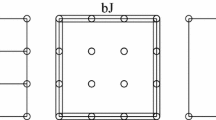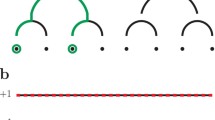Abstract
A new cluster-effective-field theory of spin glasses is formulated. Basic formulas for the spin-glass transition point and the spin-glass susceptibility in the high-temperature phase are obtained. The present theory combined with the coherent-anomaly method is shown to be useful to estimate the true critical point and the nonclassical critical exponent of a spin-glass transition. Concerning the two-dimensional ±J model, we have γ s =5.2(1) forT SG=0, which agrees well with the data by some other authors. As for the threedimensional±J model, the present tentative analysis givesT SG=1.2(1)(J/k B) and γ s =4(1), but more extensive calculations are needed.
Similar content being viewed by others
References
S. F. Edwards and P. W. Anderson, Theory of spin glasses,J. Phys. F 5:965 (1975).
K. Binder and A. P. Young, Spin glasses: Experimental facts, theoretical concepts, and open questions,Rev. Mod. Phys. 58:801 (1986).
D. Sherrington and S. Kirkpatrick, Solvable model of a spin-glass,Phys. Rev. Lett. 35:1972 (1975).
G. Parisi, Infinite number of order parameters for spin-glasses,Phys. Rev. Lett. 43:1754 (1979); A sequence of approximated solutions to the S-K model for spin glasses,J. Phys. A 13:L115 (1980); The order parameter for spin glasses: A function on the interval 0–1,J. Phys. A 13:1101 (1980); Magnetic properties of spin glasses in a new mean field theory, J. Phys. A 13:1887 (1980); Mean field theory for spin glasses,Phys. Rep. 67:25 (1980).
J. H. Chen and T. C. Lubensky, Mean field andε-expansion study of spin glasses,Phys. Rev. B 16:2106 (1977).
M. Suzuki, Statistical mechanical theory of cooperative phenomena. I. General theory of fluctuations, coherent anomalies and scaling exponents with simple applications to critical phenomena,J. Phys. Soc. Jpn. 55:4205 (1986).
M. Suzuki, M. Katori, and X. Hu, Coherent anomaly method in critical phenomena. I,J. Phys. Soc. Jpn. 56:3092 (1987).
M. Katori and M. Suzuki, Coherent anomaly method in critical phenomena. II. Applications to the two- and three-dimensional Ising models,J. Phys. Soc. Jpn. 56:3113 (1987).
S. Katsura, S. Inawashiro, and S. Fujiki, Spin glasses for the infinitely long ranged bond Ising model and for the short ranged binary bond Ising model without use of the replica method,Physica A 99:193 (1979).
M. Suzuki, Statistical mechanical theory of cooperative phenomena. II. Super-effectivefield theory with applications to exotic phase transitions,J. Phys. Soc. Jpn. 57:2310 (1988); Super-effective-field theory and exotic phase transitions in spin systems,J. Phys. (Paris)C8:1519 (1988).
M. Suzuki, Super-effective-field CAM theory of strongly correlated electron and spin systems, inRecent Progress in Many-Body Theories, Y. Avishai, ed. (Plenum, New York, to appear).
N. Kawashima and M. Suzuki, Chiral phase transition of planear antiferromagnets analyzed by the super-effective-field theory,J. Phys. Soc. Jpn. 58:3123 (1989).
G. Toulouse, Theory of the frustration effect in spin glasses. I,Commun. Phys. 2:115 (1977); E. Fradkin, B. A. Huberman, and S. H. Shenker, Gauge symmetries in random magnetic systems,Phys. Rev. B 18:4789 (1978).
F. Matsubara and M. Sakata, Theory of random magnetic mixture III-Glass-like phase,Prog. Theor. Phys. 55:672 (1976); S. Katsura and S. Fujiki, Distribution of spins and the thermodynamic properties, in the glass-like (spin glass) phase of random Ising bond models,J. Phys. C 12:1087 (1979); S. Katsura, Theory of spin glass by the method of the distribution function of an effective field,Prog. Theor. Phys. Suppl. 87:139 (1986); Errata,Prog. Theor. Phys. 79:251 (1988); M. Sasaki and S. Katsura, The asymmetric continuous distribution function of the effective field of the Ising model in the spin glass and the ferromagnetic states on the Bethe lattice,Physica A 157:1195 (1989); C. Kwon and D. J. Thouless, Ising spin glass at zero temperature on the Bethe lattice,Phys. Rev. B 37:7649 (1988).
M. Suzuki, Phenomenological theory of spin-glasses and some rigorous results,Prog. Theor. Phys. 58:1151 (1977).
S. Katsura, Random mixture of the Ising magnets in a magnetic field,Prog. Theor. Phys. 55:1049 (1976); S. Fujiki and S. Katsura, Nonlinear susceptibility in the spin glass,Prog. Theor. Phys. 65:1130 (1981).
M. E. Fisher and M. N. Barber, Scaling theory for finite-size effects in the critical region,Phys. Rev. Lett. 28:1516 (1972).
N. Ito and M. Suzuki, Size-dependence of coherent anomalies in self-consistent cluster approximations,Phys. Rev. B 43 (1991).
W. L. McMillan, Monte Carlo simulation of the two-dimensional random (±J) Ising model,Phys. Rev. B 28:5216 (1983); A. P. Young, Monte Carlo studies of short-range Ising spin glasses in zero field,J. Phys. C 18:L517 (1984).
R. R. P. Singh and S. Chakravarty, Critical behavior of an Ising spin-glass,Phys. Rev. Lett. 57:245 (1986); High-temperature series expansion for spin glasses. I. Derivation of the series, II. Analysis of the series,Phys. Rev. B 36:546, 559 (1987); Critical exponents for Ising spin glasses through high-temperature series analysis,J. Appl. Phys. 61:4095 (1987).
R. H. Swendsen and J. S. Wang, Replica Monte Carlo simulation of spin-glasses,Phys. Rev. Lett. 57:2607 (1986).
R. N. Bhatt and A. P. Young, Numerical studies of Ising spin glasses in two, three, and four dimensions,Phys. Rev. B 37:5606 (1988).
A. T. Ogielski and I. Morgenstern, Critical behavior of three-dimensional Ising spin-glass model,Phys. Rev. Lett. 54:928 (1985); Critical behavior of three-dimensional Ising model of spin glass,J. Appl. Phys. 57:3382 (1985); R. N. Bhatt and A. P. Young, Search for a transition in the three-dimensional ±J Ising spin-glass,Phys. Rev. Lett. 54:924 (1985); A. T. Ogielski, Dynamics of three-dimensional Ising spin glasses in thermal equilibrium,Phys. Rev. B 32:7384 (1985).
A. J. Bray and M. A. Moore, Lower critical dimension of Ising spin glasses: A numerical study,J. Phys. C 17:L463 (1984); R. R. P. Singh and M. E. Fisher, Short-range Ising spin glasses in general dimensions,J. Appl. Phys.63:3994 (1988); M. E. Fisher and R. R. P. Singh, Critical points, large-dimensionality expansions, and the Ising spin glass, inDisorder in Physical Systems, G. Grimmett and D. J. A. Welsh, eds. (Oxford University Press, 1990), p. 87.
W. L. McMillan, Scaling theory of Ising spin glasses,J. Phys. C 17:3179 (1984).
Author information
Authors and Affiliations
Rights and permissions
About this article
Cite this article
Hatano, N., Suzuki, M. Effective-field theory of spin glasses and the coherent-anomaly method. I. J Stat Phys 63, 25–46 (1991). https://doi.org/10.1007/BF01026590
Received:
Revised:
Issue Date:
DOI: https://doi.org/10.1007/BF01026590




